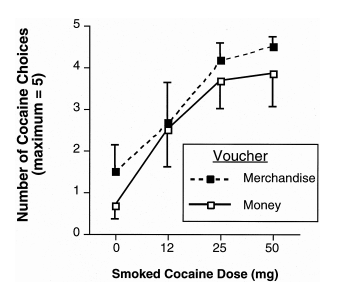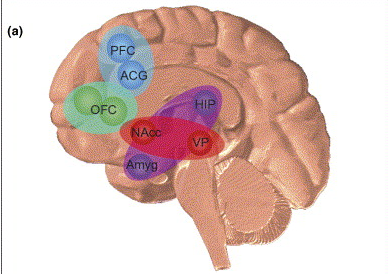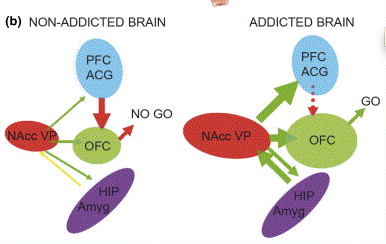Crack, dope, ice…One hit, and you’re hooked for life.

Meth: one strike you’re out? Source: http://heisenbergchronicles.tumblr.com/
That’s what the war on drugs has been telling us for years. And for a while neuroscience seemed to back it up. Drugs of abuse stimulate our dopaminergic reward centers, causing a surge of dopamine efflux that changes synaptic transmission, “rewiring” the brain to create intense feelings of craving and drug-seeking behaviours. Lab rats hooked on cocaine will keep pressing a lever for another hit, eschewing food and rest until they die. Addicts beg and steal, enslaved to their drug of choice with a relapse rate as high as 97%.
But 80-90% of people who use methamphetamine and heroin don’t get addicted; not all ex-addicts relapse. In an unpopular series of studies, collectively called “Rat Park”, rats turned their noses at free-for-all morphine, preferring instead to socialize with their rat buddies in an enriched environment.
“Drugs have the power to rob us of our free will” – is this scientific fact, or social-politically construed caricature?
Hart, CL (2000) Alternative reinforcers differentially modify cocaine self-administration by humans. Behavioural Pharmacology. 2000; 11:87-91
The authors recruited 6 experienced crack cocaine smokers, and watched how they responded when offered a choice of between pharmaceutical grade cocaine versus a $5 monetary voucher, or a $5 merchandise voucher which can be used at local stores. In other words, they were offered drugs or an alternative award.
The volunteers were invited to stay at a Clinical Research Facility with TVs, radio and movies for entertainment. They had free access to cigarettes when not in session, but weren’t allowed “extra-curricular” doses of cocaine. At the start of each experimental session, researchers presented the addicts with a voucher indicating what the alternative award is. Addicts then pressed the spacebar a keyboard to “work” for a hit of cocaine, while blindfolded so that they couldn’t tell the dose.
In the subsequent trials, addicts had the freedom to choose to get the same dose of cocaine as the sample trial. But they were also offered an alternative reward: in the first four sessions, it was 5 bucks hard cash; in the last four, a voucher worth 5 bucks which they could trade for merchandise.
As you can see below, at lower cocaine doses (0 and 12mg), addicts choose to receive the voucher (black) or the money (white) more than half of the time. At higher doses though, addicts lusted after the cocaine hit 4-5 times out of the 5 trials.
 When researchers pool all the data at various cocaine doses together, they found that out of the available 20 doses of cocaine, the addicts requested to smoke 2 doses LESS when cash was available compared to when merchandise vouchers were available. In other words, cash is a more competitive alternative reward. However, because the study did not include a condition where the participants smoked cocaine without the availability of either voucher, it’s impossible to say in absolute terms how much either the $5 or voucher decreased cocaine self-administration.
When researchers pool all the data at various cocaine doses together, they found that out of the available 20 doses of cocaine, the addicts requested to smoke 2 doses LESS when cash was available compared to when merchandise vouchers were available. In other words, cash is a more competitive alternative reward. However, because the study did not include a condition where the participants smoked cocaine without the availability of either voucher, it’s impossible to say in absolute terms how much either the $5 or voucher decreased cocaine self-administration.
All the users in the study were kept abstinent except during the trial, except for that one tease at the start of each session. According to popular beliefs, that should have triggered insane cocaine cravings and driven them to choose the drug in subsequent trials regardless of dosage. When given an alternate to cocaine, the addicts were capable of deciding that a low dose wasn’t “worth it”. They made a rational choice. Presumably the effect size would’ve been larger if the monetary reward was higher – this was indeed the case in a follow-up study with meth addicts, when the monetary reward was upped to $20.
The study is not without its faults. First, it suffers all the problems of small sample size, especially generalizability. Second, the addicts had to work for cocaine, while the alternative reward was readily available (albeit one can argue whether pressing a space bar several times can be counted as “work”). I would’ve loved to know what would’ve happened if they were offered the money first, then given the choice to keep it or spend it on a hit in the lab? And what did the addicts DO with the money after the study – did they use it to buy more drugs?
Nonetheless, the author of this study stresses that neuroscience has a lot to loose by caricaturizing addiction as the “one-hit you’re done” boogeyman – it essentially takes out all social-economic factors, and solely focuses on the drug’s pharmacology. This is understandable in one sense – studying drugs in a sterile lab out of context is simple – but perhaps a more useful approach is to understand why some, but not others, get hooked for life. The personal traits and environmental influences that bias someone towards drug addiction are mainly still unknown, though individual differences in cognitive control and early-life stressors definitely play a role.
As Mind Hacks eloquently puts it:
“Nonetheless the research does demonstrate that the standard ‘exposure model’ of addiction is woefully incomplete. It takes far more than the simple experience of a drug – even drugs as powerful as cocaine and heroin – to make you an addict. The alternatives you have to drug use, which will be influenced by your social and physical environment, play important roles as well as the brute pleasure delivered via the chemical assault on your reward circuits.”
Head over there if you’d like to read more about Rat Park and the complexity of addiction.
Hat tip to @Scicurious for news on the lead author of this study, Dr. Carl Hart, who has a book out on the topic – looks like an interesting read.
![]()
Hart CL, Haney M, Foltin RW, & Fischman MW (2000). Alternative reinforcers differentially modify cocaine self-administration by humans. Behavioural pharmacology, 11 (1), 87-91 PMID: 10821213


